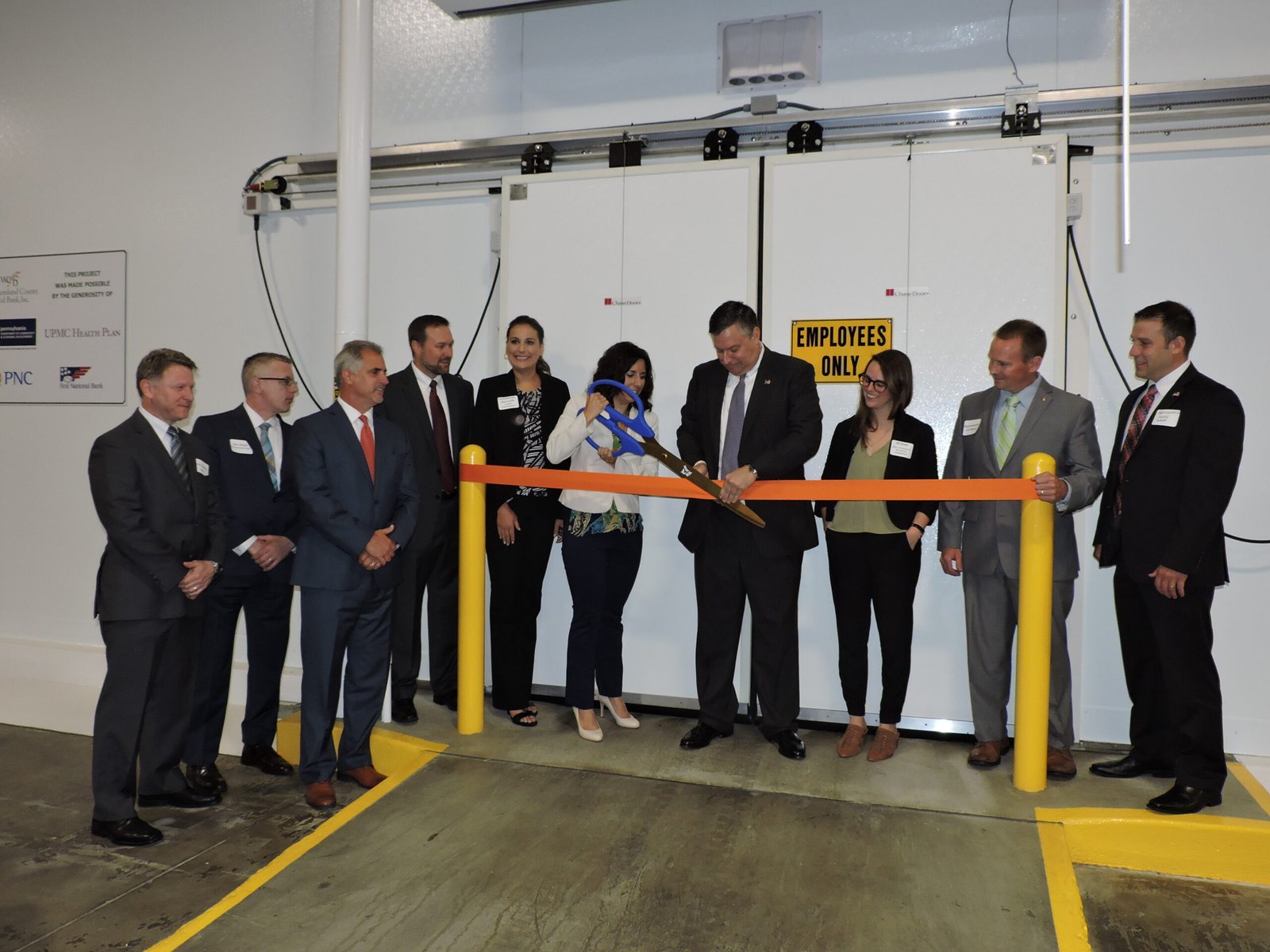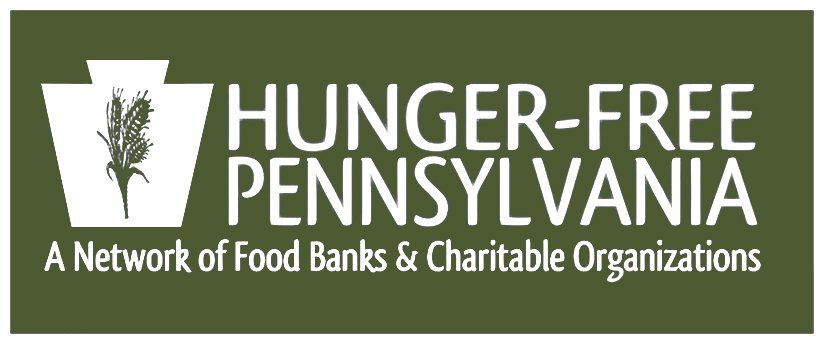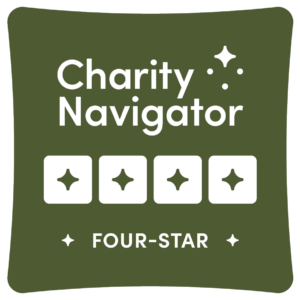
Westmoreland County Food Bank Unveils New Freezer in Partnership with the Neighborhood Assistance Program
Kris M. Douglas, Chief Executive Officer of the Westmoreland County Food Bank addressed a crowd gathered at the unveiling of their new freezer on Wednesday, and expressed how blessed they are to have such a giving community to assist us in obtaining a new freezer that was leveraged via the Department of Community and Economic Development (DCED) – Neighborhood Assistance Program (NAP).
“When we began to think about replacing the over 20 year old freezer, we never dreamed it all would happen so quickly,” said Mr. Douglas. “We are very grateful to our donors, UPMC, PNC Bank, and First National Bank who helped to make this all possible. We are also appreciative of Wellington Strategies, who assisted with the NAP application, as well as the DCED.”
The Neighborhood Assistance Program (NAP) has served as a resource for nonprofits, businesses and neighborhoods for over 3 years. NAP includes five subparts: regular NAP, SPP (Special Priorities Program), NPP (Neighborhood Partnership Program), CFP (Charitable Food Program), and EZP (Enterprise Zone Program). The goals of the Neighborhood Assistance Program (NAP) are to promote community participation and collaborations among nonprofits, businesses and residents while producing outcomes which assist a distressed area or the low income population in a neighborhood.
This past 2017-18 fiscal year, DCED received more than 190 applications, totaling over $32 million for NAP tax credits Out of that $32 million, DCED was able to award $18 million to those projects that best met the requirement guidelines laid out for NAP TAX CREDITS Currently, a total of $18 million in tax credits is budgeted each year for the entire NAP. With the change in economic situations over the last several years, tax credit programs have become a more attractive resource for organizations and businesses looking to perform community-based improvement programs. NAP IMPACT Today’s economic challenges make it difficult for neighborhoods to achieve and maintain positive environments. Crime, limited access to education, and job training, economic stagnation, poverty, and hunger, among others, are some of the challenges Pennsylvania’s neighborhoods face. NAP promotes a shared belief that healthy, thriving neighborhoods are a cornerstone of Pennsylvania’s success by:
- Offering generous tax credits to businesses in exchange for financial contributions to nonprofit, community-based organizations working in low-income and distressed neighborhoods.
- Lowering the costs to businesses when they make contributions or invest in expansion for job creation and neighborhood stabilization and revitalization, especially in the designated enterprise zones.
- Providing a mechanism for blighted neighborhoods to be revived.
- Continually linking businesses to community organizations, which is mutually beneficial.
Charitable Food Program (CFP) assists food banks, pantries, and emergency food providers (i.e. soup kitchens) that supply food to a target population in a distressed area. Target areas of high incidence of food insecurity as defined by the United States Department of Agriculture Food and Nutrition Service. Donations may be cash contributions or in-kind food donations. Tax credits at 55% on business contribution.
Also addressing those gathered at the food bank included David Serafini from PNC, Paul Puleo from First National Bank, Dana Scarpino from UPMC, and Chad Amond of the Westmoreland Chamber of Commerce.
If you would like to learn more about the Westmoreland County Food Bank and how they assist your community, please visit their website at www.westmorelandfoodbank.org or contact them at 724-468-8660.
Pictured in the photo attached are (from left to right):
- David Serafini, PNC
- Alan Bicker, First National Bank
- Paul Puleo, First National Bank
- Chad Amond, Westmoreland County Chamber of Commerce
- Gina Cerilli, Westmoreland County Commissioner
- Dana Scarpino, UPMC Health Plan
- Kris Douglas, CEO – Westmoreland County Food Bank
- Aly Doyle, Department of Community & Economic Development
- Representative Eric Nelson
- Representative Justin Walsh
About Westmoreland County Food Bank
The Westmoreland County Food Bank serves over 31,000 area residents each year including approximately 9,300 children and 3,410 seniors. WCFB currently has 60 member agencies in their network of emergency feeding sites. Of those, 43 are food pantries in which low income consumers are able to access emergency food assistance throughout the month. Last year (2017), the Food Bank distributed over 9 million pounds of food.
50% of WCFB’s food comes from the federal and state governments and the remaining 50% from local donations, food drives, and Feeding America. Administrative and fundraising costs account for 4% of the Food Bank’s operating budget.
Share this article...

Westmoreland County Food Bank Unveils New Freezer in Partnership with the Neighborhood Assistance Program
Kris M. Douglas, Chief Executive Officer of the Westmoreland County Food Bank addressed a crowd gathered at the unveiling of their new freezer on Wednesday, and expressed how blessed they are to have such a giving community to assist us in obtaining a new freezer that was leveraged via the Department of Community and Economic Development (DCED) – Neighborhood Assistance Program (NAP).
“When we began to think about replacing the over 20 year old freezer, we never dreamed it all would happen so quickly,” said Mr. Douglas. “We are very grateful to our donors, UPMC, PNC Bank, and First National Bank who helped to make this all possible. We are also appreciative of Wellington Strategies, who assisted with the NAP application, as well as the DCED.”
The Neighborhood Assistance Program (NAP) has served as a resource for nonprofits, businesses and neighborhoods for over 3 years. NAP includes five subparts: regular NAP, SPP (Special Priorities Program), NPP (Neighborhood Partnership Program), CFP (Charitable Food Program), and EZP (Enterprise Zone Program). The goals of the Neighborhood Assistance Program (NAP) are to promote community participation and collaborations among nonprofits, businesses and residents while producing outcomes which assist a distressed area or the low income population in a neighborhood.
This past 2017-18 fiscal year, DCED received more than 190 applications, totaling over $32 million for NAP tax credits Out of that $32 million, DCED was able to award $18 million to those projects that best met the requirement guidelines laid out for NAP TAX CREDITS Currently, a total of $18 million in tax credits is budgeted each year for the entire NAP. With the change in economic situations over the last several years, tax credit programs have become a more attractive resource for organizations and businesses looking to perform community-based improvement programs. NAP IMPACT Today’s economic challenges make it difficult for neighborhoods to achieve and maintain positive environments. Crime, limited access to education, and job training, economic stagnation, poverty, and hunger, among others, are some of the challenges Pennsylvania’s neighborhoods face. NAP promotes a shared belief that healthy, thriving neighborhoods are a cornerstone of Pennsylvania’s success by:
- Offering generous tax credits to businesses in exchange for financial contributions to nonprofit, community-based organizations working in low-income and distressed neighborhoods.
- Lowering the costs to businesses when they make contributions or invest in expansion for job creation and neighborhood stabilization and revitalization, especially in the designated enterprise zones.
- Providing a mechanism for blighted neighborhoods to be revived.
- Continually linking businesses to community organizations, which is mutually beneficial.
Charitable Food Program (CFP) assists food banks, pantries, and emergency food providers (i.e. soup kitchens) that supply food to a target population in a distressed area. Target areas of high incidence of food insecurity as defined by the United States Department of Agriculture Food and Nutrition Service. Donations may be cash contributions or in-kind food donations. Tax credits at 55% on business contribution.
Also addressing those gathered at the food bank included David Serafini from PNC, Paul Puleo from First National Bank, Dana Scarpino from UPMC, and Chad Amond of the Westmoreland Chamber of Commerce.
If you would like to learn more about the Westmoreland County Food Bank and how they assist your community, please visit their website at www.westmorelandfoodbank.org or contact them at 724-468-8660.
Pictured in the photo attached are (from left to right):
- David Serafini, PNC
- Alan Bicker, First National Bank
- Paul Puleo, First National Bank
- Chad Amond, Westmoreland County Chamber of Commerce
- Gina Cerilli, Westmoreland County Commissioner
- Dana Scarpino, UPMC Health Plan
- Kris Douglas, CEO – Westmoreland County Food Bank
- Aly Doyle, Department of Community & Economic Development
- Representative Eric Nelson
- Representative Justin Walsh
About Westmoreland County Food Bank
The Westmoreland County Food Bank serves over 31,000 area residents each year including approximately 9,300 children and 3,410 seniors. WCFB currently has 60 member agencies in their network of emergency feeding sites. Of those, 43 are food pantries in which low income consumers are able to access emergency food assistance throughout the month. Last year (2017), the Food Bank distributed over 9 million pounds of food.
50% of WCFB’s food comes from the federal and state governments and the remaining 50% from local donations, food drives, and Feeding America. Administrative and fundraising costs account for 4% of the Food Bank’s operating budget.










